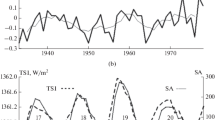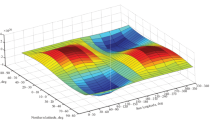Abstract
Quantitative indicators of the influence of the shape of the Earth (ellipsoidal with modern polar compression or spherical) on the characteristics of its irradiation calculated without taking into account the changes in the solar activity have been obtained. The differences between specific energies as well as intensities of irradiation of the ellipsoid (and its parts) and sphere (and its parts) on the average over a tropical year and in its parts (half-years, months) have been revealed. It is found from the data on the Earth’s motion in the interval of the tropical years from 3000 BC to AD 2999 that, at a constant intensity of solar irradiance, each of the two annual irradiation characteristics for the sphere is 0.085% higher than one for the ellipsoid. The monthly irradiation specific energy for the sphere is almost constant, and one for the ellipsoid varies with a scatter 0.043% of the average value (minima at the equinoxes and maxima at the solstices). The monthly irradiation intensities for the sphere and ellipsoid vary synchronously with a scatter 5.98% relative to the average value (the minimum occurs in the third month and the maximum in the ninth). The seasonality for a hemisphere (absolute value of the difference between irradiation specific energies for a hemisphere in different half-year periods) in the case of the ellipsoidal Earth is on the average 0.223% higher than in the case of the spherical Earth. The maximum of differences in the semiannual irradiation specific energies (and similarly in the semiannual irradiation intensities) in the latitudinal zones of the sphere and ellipsoid is positive and the minimum is negative. In the first half of the year, the maximum and minimum are observed in the zones 45°–50° S and 10°–15° N. In the second half of the year, the maximum and minimum are observed in zones 45°–50° N and 10°–15° S. It is found on the basis of the data from 1978–2008 that the differences in the intensities of irradiation of the sphere and ellipsoid are comparable with the variations in the total solar irradiance (TSI) associated with the changes in solar activity. The mean absolute value of the annual TSI anomaly is 14.01% greater than the average annual difference in the intensities of irradiation of the sphere and ellipsoid. The average absolute value of the monthly TSI anomaly exceeds the average monthly difference in the intensities of the irradiation of the sphere and ellipsoid by 23.37%.








Similar content being viewed by others
REFERENCES
Berger, A.L., Long-term variations of caloric insolation resulting from the Earth’s orbital elements, Quat. Res., 1978, vol. 9, pp. 139–167.
Berger, A., Loutre, M.F., and Yin, Q., Total irradiation during any time interval of the year using elliptic integrals, Quat. Sci. Rev., 2010, vol. 29, pp. 1968–1982. https://doi.org/10.1016/j.quascirev.2010.05.07
Bertrand, C., Loutre, M.F., and Berger, A., High frequency variations of the Earth’s orbital parameters and climate change, Geophys. Res. Lett., 2002, vol. 29, no. 18, pp. 40-1–40-3. https://doi.org/10.1029/2002GL015622
Brouwer, D. and Van Woerkom, A.J.J., The secular variation of the orbital elements of the principal planets, Astro-n. Pap., 1950, vol. 13, pp. 81–107.
Cionco, R.G. and Soon, W.W.-H., Short-term orbital forcing: A quasi-review and a reappraisal of realistic boundary conditions for climate modeling, Earth Sci. Rev., 2017, vol. 166, pp. 206–222.
Dergachev, V.A. and Volobuev, D.M., Solar radiation change and climatic effect on decennial – centennial scales, Geomagn. Aeron., 2018, vol. 58, no. 8, pp. 1042–1049.
Fedorov, V.M., Spatial and temporal variations in solar climate of the Earth in the present epoch, Izv., Atmos. Ocean. Phys., 2015, vol. 51, no. 8, pp. 779–791. https://doi.org/10.1134/S0001433815080034
Fedorov, V.M. and Frolov, D.M., Spatial and temporal variability of solar radiation arriving at the top of the atmosphere, Cosmic Res., 2019, vol. 57, no. 3, pp. 156–162. https://doi.org/10.1134/S0010952519030043
Fedorov, V.M., Earth’s insolation variation and its incorporation into physical and mathematical climate models, Phys.–Usp., 2019, vol. 62, no. 1, pp. 32–45. https://doi.org/10.3367/UFNe.2017.12.038267
Fedorov, V.M. and Kostin, A.A., The calculation of the Earth’s insolation for the 3000 BC – AD 2999, Processes Geomedia, 2020, no. 1, pp. 181–192. https://doi.org/10.1007/978-3-030-38177-6_20
Folkner, W.M., Williams, J.G., Boggs, D.H., Park, R.S., and Kuchynka, P., The planetary and Lunar ephemerids DE430 and DE431, IPN Progress Rep. February, vol. 42-196, pp. 1–81.
Kopp, G. and Lean, J.L., A new, lower value of total solar irradiance: evidence and climate significance, Geophys. Rev. Lett., 2011, vol. 38, paper ID L01706. https://doi.org/10.1029/2010GL045777
Laskar, J., Joutel, F., and Boudin, F., Orbital, precessional and insolation quantities for the Earth from –20 Myr to +10 Myr, Astron. Astrophys., 1993, vol. 287, pp. 522–533.
Milankovitch, M., Mathematische Klimalehre und astronomische Theorie der Klimaschwankungen, Berlin: Borntraeger, 1930.
Sharaf, Sh.G. and Budnikova, N.A., On secular variations in the Earth’s orbital elements that affect the climates of geological past, Byull. Inst. Teor. Astron. Akad. Nauk SSSR, 1967, vol. 11, no. 4 (127), pp. 231–261.
Standish, E.M., Orientation of the JPL ephemerides, DE200/LE200, to the dynamical equinox of J2000, A-stron. Astrophys., 1982, vol. 114, pp. 297–302.
Trenberth, K.E., Fasullo, J.T., and Kiehl, J., Earth’s global energy budget, Bull. Am. Meteorol. Soc., 2009, pp. 311–323. https://doi.org/10.1175/2008BAMS2634.1
Tsvetkov, A.V. and Agaponov, S.V., On some characteristics of insolation changes in the past and the future, Clim. Change, 1983, no. 5, pp. 237–244.
Vernekar, A., Long-Period Global Variations of Incoming Solar Radiation, Boston, MA: Am. Meteorol. Soc., 1972.
Funding
This research was carried out as part of State Task “Paleoclimates, Development of the Natural Environment and Long-Term Forecast of Its Changes” (no. АААА-А16-116032810080-2).
Author information
Authors and Affiliations
Corresponding author
Ethics declarations
The authors declare no conflicts of interest.
Additional information
Translated by E. Morozov
Rights and permissions
About this article
Cite this article
Fedorov, V.M., Kostin, A.A. & Frolov, D.M. Influence of the Shape of the Earth on the Characteristics of the Irradiation of the Earth. Izv. Atmos. Ocean. Phys. 56, 1301–1313 (2020). https://doi.org/10.1134/S0001433820100035
Received:
Revised:
Accepted:
Published:
Issue Date:
DOI: https://doi.org/10.1134/S0001433820100035




